It’s summer. There are ripe tomatoes in the garden. The hens are hot and drink a lot of water.
One hen is broody and others are laying.
At first glance, all appears the same as it’s been all summer. But look again. There are long feathers on the floor of the coop, and there are downy feathers piling up in the corners. The molt begins.
Pearl, the Cochin, is still fluffy, but her feathers look loose, as if a passing breeze might blow them all off.
Her legs, usually hidden by feathers, are now visible.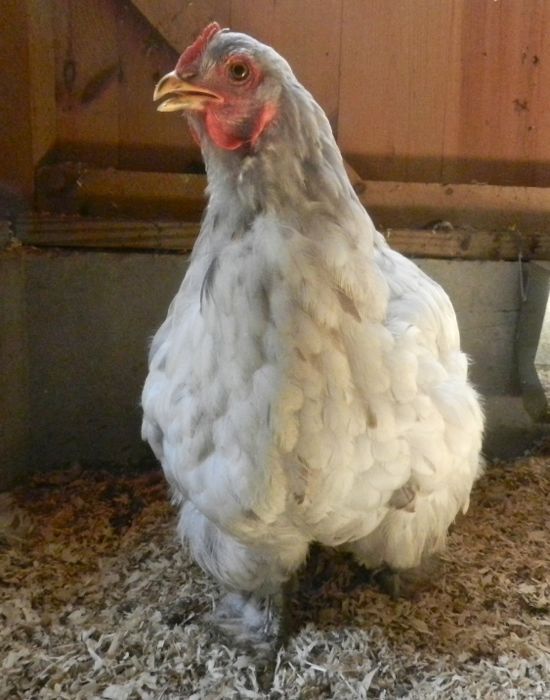
There’s subtle signs of the molt in other hens, too. Amber, the Rhode Island Red, is usually sleek as can be, with nary a feather out of place.
Observe the feathers on her back. She’s molting.
Just like a forest doesn’t lose all of it’s leaves in one day in autumn, so too a flock doesn’t molt all at once. The girls will be shedding feathers for months. Laying will slow down and then stop. Right now I have a glut of eggs in the refrigerator, but know that the abundance won’t last. Even during a week when the weather seems constant, (hot and humid!) keeping hens makes me aware of the change of seasons and the passing of time.
For more about the molt, read my FAQ.
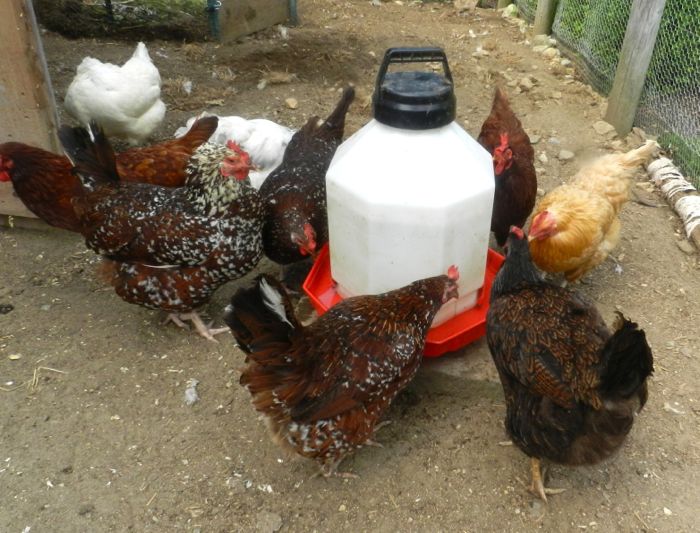

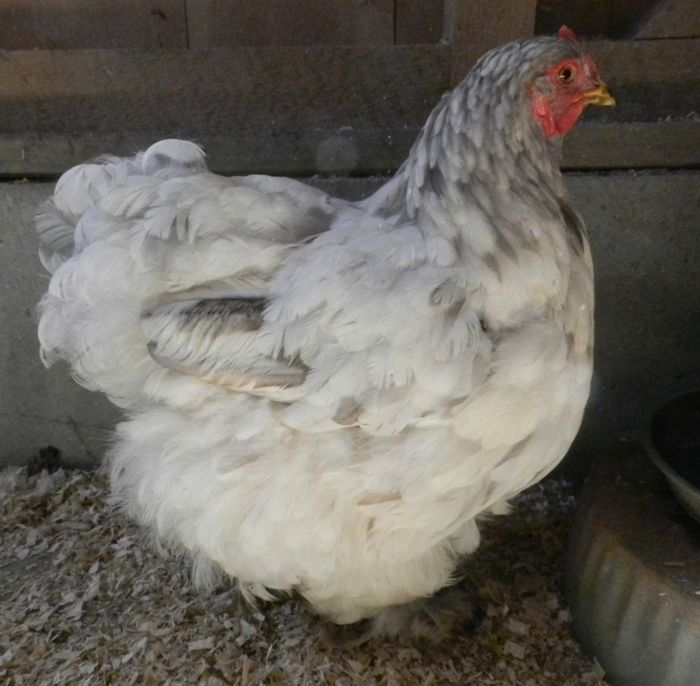
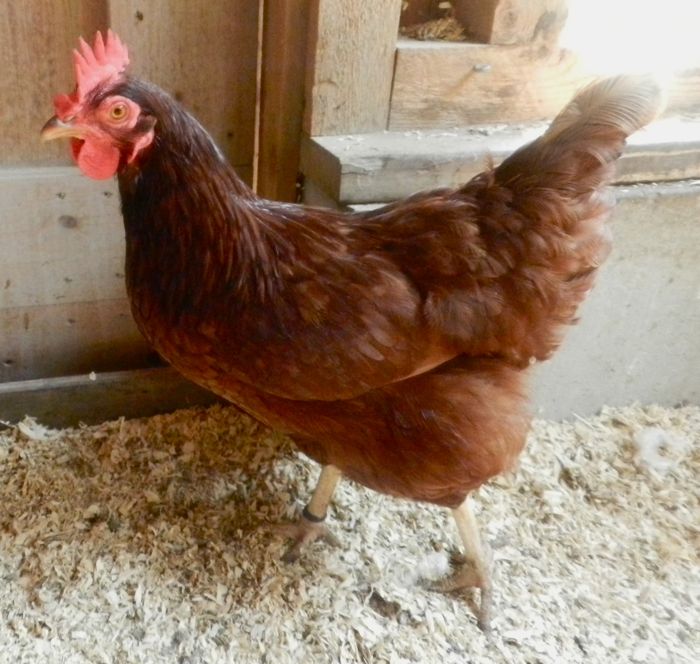
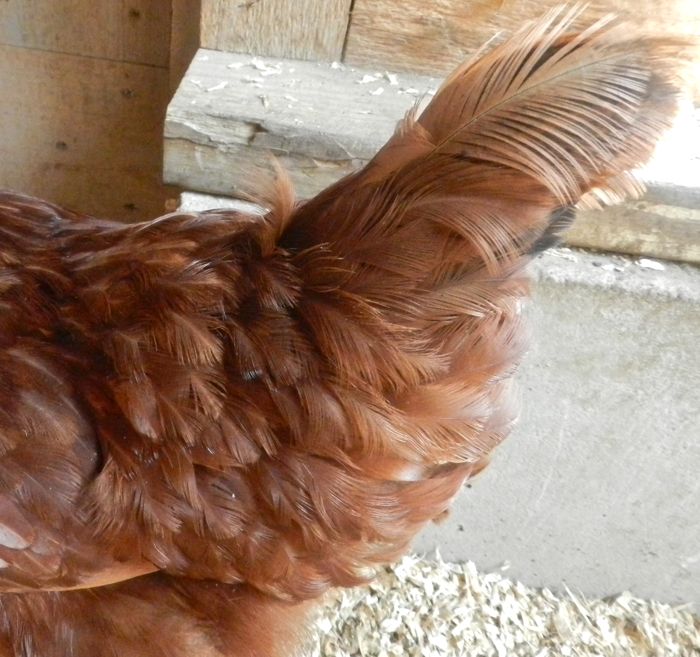

Hi Terry, Do you make any dietary changes when your hens are molting? If so, what kinds of food would you offer and for how long?
Thanks, Kim
It’s helpful for them to get additional protein. I write about what I do in the Molting FAQ. (The FAQ is different than this post and has a funny photo of Lulu. Worth seeing!)
Do we change their food as soon as we see one starting to molt? Is it bad for others to eat before they start molting? Thanks for the timely info, Terry!
As long as they’re on a healthy diet to begin with, they’ll be fine. Too much protein can cause kidney damage (I’ve heard of this happening to flocks when the owners get over-zealous with mealworms.) If your hens are free-ranging, this time of year they’re feeding on plenty of bugs and greens! But, a handful of hulled sunflower seeds tossed to the flock, anytime, can’t hurt. Anyway, when they’re losing their feathers they don’t need the extra protein, it’s when you see them growing new ones in. My older hens have a harder time with this than the young ones. When most of them are in full-out, pocupiney molt, I add the supplements.
I’ve been finding feathers of all sizes in our temp coop, a 10 x 10 fortified dog pen, for weeks. Since my hens are only 7 months old it’s not a molt, but there IS a bully hen and perhaps the feathers are due to stress and the bullying. In fact, when a hen is squatting for me, or just allowing me to pet her, I have to protect her head with my other hand to keep the bully from pecking at her eyes.
My girls are only 3.5 months old and going thru their juvenile molt. Feathers everywhere but they look as tidy as ever. Do you think they need a little extra protein at this age? They are still on starter crumbles.
I should have mentioned the juvenile molt in the FAQ. Starter crumbles should take care of their needs. It’s higher in protein than laying hen pellets. Don’t add anymore. Greens and exercise are good for that age.
Looks like a fox got into my chicken coop.
Yes, I end up counting the hens even though I know they’re all there!
Yep..I noticed it too last night when I went to collect eggs. A nice downy pile of feathers all piled in the nesting boxes. I have to say….I HATE molting season. The feather mess is something else! On a good note…while raking my coops up last night I saw something shiny in the pile of shavings…OMG…a ring I bought myself in Hawaii when I turned 50 with my name engraved on it that I payed for with EGG money! It has been gone for 3 years! Taking it for a polish tomorrow….Gotta love that! Thought it was gone for good!
Amazing that you found the ring and that one of the hens didn’t swallow it first (hmmm, maybe one did… ) I heard from someone who gets the feathers up with a shop vac. Great idea!
What do you do with the feathers? Are they compost-able?
They go in the compost, but do take a long time to break down. If you have the room, having a compost pile for the slow stuff, like tough corn cobs, branches and feathers, allows the daily compost to be useful sooner.
My chickens are about four and a half months now and I too have been finding plenty of feathers, both down and proper feathers. The chooks don’t look any different though. I assumed this was normal and am reassured by others finding the same. Mine are on growers pellets at the moment but I give a small amount of treats, meal worms or sunflower hearts in very small amounts, late afternoon and greens to peck at during the day. I am always gratefully sponging up any information from you.
My girls are only five months. Will they molt this fall too? They are just starting to lay so I hate for it to end so soon.
They do a juvenile molt, but it’s not the same thing. Just a few feathers flying and they don’t stop laying because of it. The big, adult molt isn’t until they’re just under 2 years of age.
OT, Terry I’m sooooo jealous. I clicked on the hen cam and what do I see? Water droplets on the lens of the camera and hens walking around with their backs and tails pointed downward!!! RAIN!!!!!!!!!!!!!!!!!!
Ken, don’t be jealous – there’s a tornado warning west of here! I’m in the safe zone, but there’s going to be dangerous flooding and lightning. Which just proves “it never rains but it pours.”
Maybe after the molt the GEMS will stop picking on Jasper’s feathers?!
One could only hope. But, I think she likes it!
That is too funny Terry. I am also jealous of your rain you are having now!
Yup, had 2 tornado warnings while at the NOFA Summer Conference at UMASS/Amherst yesterday afternoon. Poured like crazy here for hours, some lightning. Predicted well over 1″ of rain through tonight. Another rainy day at the conference.
Terry, I checked the FAQ and saw you’d mentioned the early molters. That’s definitely proved true here. Last year the layers culled at pretty poor quality. I had all I could do the get the 16 I needed from the 50 to select from. I had to keep really marginal birds to make the 16. And sure enough, the laying has been poor, they almost all molted late spring into summer. But they will be going to freezer camp the end of August, when we cull the new flock for replacements.
I’ve found that upping protein supplementation to 1/2 oz/bird/day of animal source greatly decreased the length of time for a molt. It must not exceed 10% of daily feed ration, so needs to be adjusted for smaller birds, etc. We use ground ocean fish as we have a good cheap source. So far, our eggs fly off the shelves, so no fishy taste. But we carefully weigh the daily allotments and freeze them, so there’s no mistake. They normally get 1/4 oz/bird/day.
This is the first year we’ve had the drifts of feathers in the coop. And the first year we’ve had a really bare bird, a Partridge Rock. She’s taken to not hanging with her normal pals, staying off by herself. Either she’s afraid of picking due to the extreme bareness, or she’s embarrassed to be so naked. :)
Do you think that your high cull numbers are due to the quality of the chicks purchased from a hatchery? My vintage poultry keeping books have entire chapters on how to recognize the birds to cull and the ones to keep through the winter to breed the next year. I wonder if we’re not selecting for those traits anymore.
One of my partridge Rocks started molting early as well, but is really bare in places. She too is not hanging with her PALS and is constantly grooming herself! I feel bad for her. The others are loosing their feathers, but just a few here and there.
do your gang have peculiar moulting habits? As mine get older, they get more quirky. As youngsters, they do a catastrophic moult, oven-ready overnight. Older girls just go plain odd – Dixie refuses to eat and stands motionless in the run. Big Girl (dec’d) would properly crow in the morning for two weeks, Bibby chases her own tail, Gladys (7) pretends she is at death’s door for visitors, tail down, head tucked into breast, but perks up at corn-time. Babbs loses her tail, then nothing else for a month before going bald. I’m getting at least three eggs a week from my old folks home of ten ‘layers’… time for babies in the spring I think.
I’m still waiting for my first egg :( they are 18 weeks…..I’m jealous of all the egg stories… they are healthy as can be, roam the yard at least 4-5 hours a day, they feast in my garden and love when I give them cantalope and grapes…..guess I’m impatient.
Patience! You’ll have those eggs soon :)
Losing patience, because we spoiled them so much that the minute they see our backdoor open, they want out ~bawk~bawk~bawk~ I have 4 black australorpes….I’m just wondering how they know where to lay…. we have 2 boxes but nothing yet…..as much as I love them, they seem to be somewhat stupid….we cuddled them as chicks but now it’s like they’re teenagers and want nothing to do with us unless I have treats….basically I’m jealous of your gems….your girls are gems
They are chickens! Yes, they’re dim-witted :) Australorps mature late. They’ll lay… put a couple of fake eggs in the nesting boxes and they’ll decide to leave their eggs there, too. As far as cuddling – I don’t. I handle them enough that I can pick all of them up, and when I’m in the yard, we have a companionable interaction. I make sure that not all of my interactions with them involve food. They’re used to me coming and going. They’re hopeful I have something to eat, but accept that there are times that I don’t feed them. It makes for calm and mutually pleasant time together.
I know I need some patience….I will try the fake egg, (never thought of that) they are so used to a routine of Doug going out in the morning to give fresh water and feed then me letting them out in the yard….just tonight in the coop 2 of the girls let me pet them, so I do have hope…..thanks so much for your knowledge and encouragement..
I found this and thought of you and your chickens. https://www.facebook.com/photo.php?fbid=10151011721043575&set=a.364127313574.154579.43564513574&type=1&theater
Sweet.